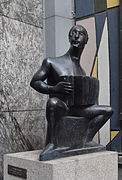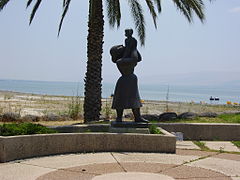Chana Orloff
Chana Orloff ( Hebrew אורלוף חנה, also called Hanna Orloff , born July 12, 1888 in Starokostjantyniw , Russian Empire ; died December 18, 1968 in Ramat Gan , Israel ) was a French-Israeli sculptor of Ukrainian origin. In the interwar period in Paris she became an important artist in the cosmopolitan art scene of the École de Paris , and later a pioneer of early Israeli art. She created more than 500 documented figurative sculptures from different materials, since the 1950s also monuments in Israel.
life and work
Chana Orloff was born as the eighth of nine children of Jewish parents, Raphael and Rachel (nee Lipschitz) Orloff, in the small settlement of Starokostjantyniw (Ukrainian Старокостянтинів ) in Ukraine. As a teenager she attended a sewing school. Her father, an admirer of the Zionist Theodor Herzl , decided to immigrate to Ottoman Palestine in 1905 as part of the second Aliyah in response to the rise in anti-Semitism and pogroms in which thousands of Jews were killed . The Orloff family settled in Petach Tikwa . The father worked as a farm laborer, Chana Orloff contributed to the living as a tailor and seamstress. She joined the HaPoel HaZair youth movement . She later designed dresses for women in the region. During this time she met artists and writers, including Samuel Agnon , Josef Chaim Brenner and the painter and sculptor Nachum Gutman . After the prospect of a job as a sewing teacher at a girls' school in Herzliya , she decided in 1910 at the age of 22 to go to Paris alone to complete a design course and work in fashion. She began an apprenticeship in the Paquin fashion studio .
In 1911 she switched from the world of fashion to art. She enrolled in sculpture at the École nationale supérieure des arts décoratifs and attended courses for young women at the Petite École, where she studied art history, drawing and anatomy. She regularly copied canonical works of European art in the Louvre . At the same time, she learned French and researched avant-garde art styles at the free Académie Russe , which Marie Vassilieff founded in 1909 for young Russian artists at Montparnasse . Orloff befriended poets and painters who visited the neighborhood, including Pablo Picasso , Tsuguharu Foujita , Diego Rivera , Guillaume Apollinaire , Jean Cocteau, as well as Chaim Soutine , Jules Pascin and Ossip Zadkine . In 1912 she met the then unknown Amedeo Modigliani , to whom she introduced her friend and classmate Jeanne Hébuterne . In the circle around Modigliani she was a central figure in the diaspora culture of Jewish artists and intellectuals in Paris.
From 1913 her works were represented in the Salon d'Automne , then in the Salon des Tuileries and Salon des Indépendants . Since then she has been attributed to the artists of the Modern École de Paris . Her style was moderately cubist and she eschewed decorative effects. Their preferred material was wood. She also worked with stone, marble, bronze and molded concrete (béton moulé), with which she first experimented in 1918. Like Vassilieff, Lempicka and Delaunay , she was one of the Parisian artists from Russia and Eastern Europe who were involved in avant-garde movements.
In 1916, Orloff married the Polish poet Ary Justman (born 1888), with whom she had their son Élie, born in 1918, whom she named Didi. Justman died of the Spanish flu in 1919 . Sculptures that she created afterwards often have the following themes: her son and mother with child.
In 1919 she published a collection of woodcuts with which she portrayed eleven artist friends under the title Bois graves de Chana Orloff . Between 1919 and 1923 she worked on other such albums, which she called Figures d'aujourd'hui . A series of portraits was created by important artists from the period after the First World War , including Alexander Jakowlew and Lucien Vogel .
Your friends Edmond Fleg and his wife Madeleine have taken her to the literary salon of Natalie Clifford Barney one. This made her an unofficial portraitist of the Parisian elite. In 1922, the American culture magazine Vanity Fair presented their carved wooden portraits of poets, writers and architects, including Lucette Schwob , Gaston Picard , Pierre Chareau and Madeleine Fleg. Her first solo exhibition in New York in 1924 was also promoted by Vanity Fair magazine, which presented her as “one of the most interesting figures in artistic life in Paris.” In 1925, Chana Orloff was naturalized in France and was awarded an Order of Merit of the Legion of Honor. From 1928 she exhibited all over Europe; In 1929 she had a second solo exhibition in New York ; the Petit Palais (Paris) dedicated a room to her works in 1937.
In 1940 and 1942 she lived in occupied Paris , where, under constant danger, she created series of small pieces that she called “pocket sculptures”. With the help of friends, she managed to flee to Switzerland with her son in 1942. Until the end of the Second World War she spent as a refugee in Geneva . When she returned to Paris in 1945, she found her apartment ransacked, around a hundred of her sculptures in her studio in Villa Seurat had been destroyed or disappeared. She moved to New York, where she worked and exhibited, and returned to Paris in 1948.
Her sculpture Le Retour , which she realized immediately after her return from Switzerland, depicts a deportee and is considered a turning point in her work. In the text for the 2013 exhibition at the Musée d'art et d'histoire du Judaïsme in Paris, it says: “She gives up the smooth shape, the curves, for more restless modeling. With small touches she leaves the imprint of her hands on the clay, forcing the eyes to penetrate the agony. Many preparatory drawings of great intensity helped her to free herself from the fear that weighed on her. ”It was 17 years before she showed Le Retour to the public for the first time as a work of art in the Katia Granoff Gallery in 1962.
She spent 1949 in Israel. In the 1950s she created a statue of David Ben-Gurion and numerous figurative, partly monumental works for the public space in Israel, such as the Olei haGardom Memorial in Ramat Gan for Irgun and Lechi underground fighters . The sculpture Maternité is dedicated to Chana Tuchman Alderstein, a female member of Kibbutz En Gev who died in the 1948 Palestinian War. Orloff presented her larger than life as the universal symbol of a woman as a mother. In an interview she said: “For this monument we need the hands of a woman and the spirit of a Jewish woman who is shaped by the past and the present of her people. ..] The Jewish woman I see here is like a tree. "
Retrospectives were held in museums in Europe, the USA and Israel . In Israel, her work was initially assigned to the German School , then to the Cubist and Jewish School of Paris .
Orloff traveled to prepare a large exhibition of her work at the Tel Aviv Art Museum on the occasion of her 80th birthday. But when she arrived at Lod Airport, she felt so bad that she was taken to Tel HaShomer , a district of Ramat Gans, to the hospital , where she died on December 18, 1968. The retrospective with 120 sculptures and 60 drawings took place in 1969 in the Helena Rubinstein Pavilion of the art museum.
literature
- Erna Stein : Orlowa, Chana . In: Hans Vollmer (Hrsg.): General lexicon of fine artists from antiquity to the present . Founded by Ulrich Thieme and Felix Becker . tape 26 : Olivier – Pieris . EA Seemann, Leipzig 1932, p. 52-53 .
- Orlova, Chana . In: Hans Vollmer (Hrsg.): General Lexicon of Fine Artists of the XX. Century. tape 3 : K-P . EA Seemann, Leipzig 1956, p. 522-523 .
- Orloff, Chana . In: General Artist Lexicon . The visual artists of all times and peoples (AKL). Volume 93, de Gruyter, Berlin 2017, ISBN 978-3-11-023259-2 , p. 459.
- Orloff, Chana. In: Encyclopaedia Judaica . 1971, vol. 12, col. 1472.
- Maryann De Julio: Chana Orloff. In: Jewish Women's Archive (Ed.): Jewish Women: A Comprehensive Historical Encyclopedia. February 27, 2009 ( jwa.org ).
- Chana Orloff (1888-1968). In: Jewish Virtual Library
- Paula J. Birnbaum: Chana Orloff. A modern Jewish woman sculptor of the School of Paris . In: Journal of Modern Jewish Studies . tape 15 , no. 1 , 2016, ISSN 1472-5886 , p. 65-87 , doi : 10.1080 / 14725886.2015.1120430 .
- Alastair Duncan : Encyclopedia of Art Deco. William Collins, Sydney 1988, ISBN 0-7322-0013-X , p. 135.
Web links
- Exhibitions by Chana Orloff at Artfacts
- Literature by and about Chana Orloff in the SUDOC catalog (Association of French University Libraries)
- La galeriste Katia Granoff présente l'artiste Chana Orloff , December 30, 1962, Elle @ centrepompidou (video)
- 1926, la Maison-atelier de Chana Orloff by Auguste Perret. (with photos of her studio in Paris), in: Architectures à vivre, 2013
Individual evidence
- ↑ a b c d Maryann De Julio: Chana Orloff. In: Jewish Women's Archive (Ed.): Jewish Women: A Comprehensive Historical Encyclopedia. February 27, 2009 ( jwa.org ).
-
↑ Orlowa, Chana . In: Hans Vollmer (Hrsg.): General Lexicon of Fine Artists of the XX. Century. tape 3 : K-P . EA Seemann, Leipzig 1956, p. 522-523 . Other publications give December 16 as the date of death.
- ^ Ary Justman , at bnf.
- ^ Robert Rey: Le Portraits Sculptés de Mme Chana Orloff. In: Art et décoration: revue mensuelle d'art modern. January 1922, pp. 57-60 ( gallica.bnf.fr ).
- ↑ The Recent Revival of Portrait Carving in Wood, Examples by Chana Orloff, the Russo-French Sculptress, who is heading this Revival in France. In: Vanity Fair . October 1922, p. 52 ( babel.hathitrust.org ).
- ^ Paula J. Birnbaum: Chana Orloff: Sculpturing as a Modern Jewish Morther. In: Rachel Epp Buller: Reconciling Art and Motherhood. Routledge, London / New York 2016, ISBN 978-1-4094-2613-4 , p. 45.
- ↑ Chana Orloff. Le Retour, 1945. Text for the exhibition in the Musée d'art et d'histoire du Judaïsme, July to October 2013, accessed on April 22, 2018.
- ^ Paula J. Birnbaum: Chana Orloff: Sculpturing as a Modern Jewish Morther. In: Rachel Epp Buller: Reconciling Art and Motherhood. Routledge, London / New York 2016, ISBN 978-1-4094-2613-4 , p. 51.
| personal data | |
|---|---|
| SURNAME | Orloff, Chana |
| ALTERNATIVE NAMES | Orloff, Hanna |
| BRIEF DESCRIPTION | French-Israeli sculptor |
| DATE OF BIRTH | July 12, 1888 |
| PLACE OF BIRTH | Starokostjantyniw , Ukraine |
| DATE OF DEATH | 18th December 1968 |
| Place of death | Ramat Gan , Israel |






